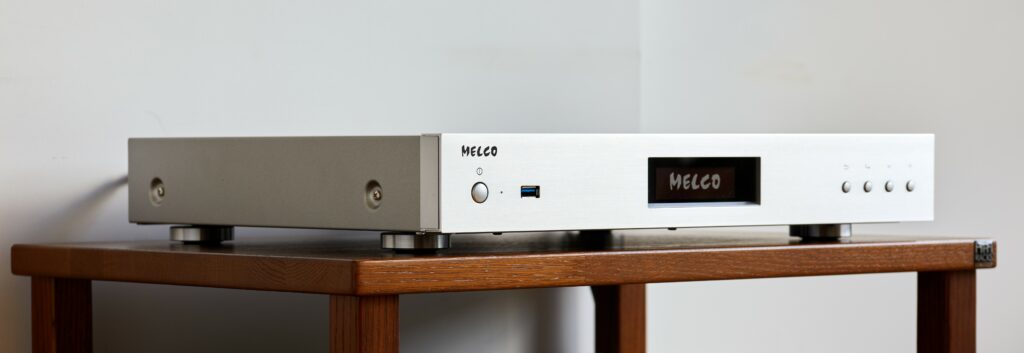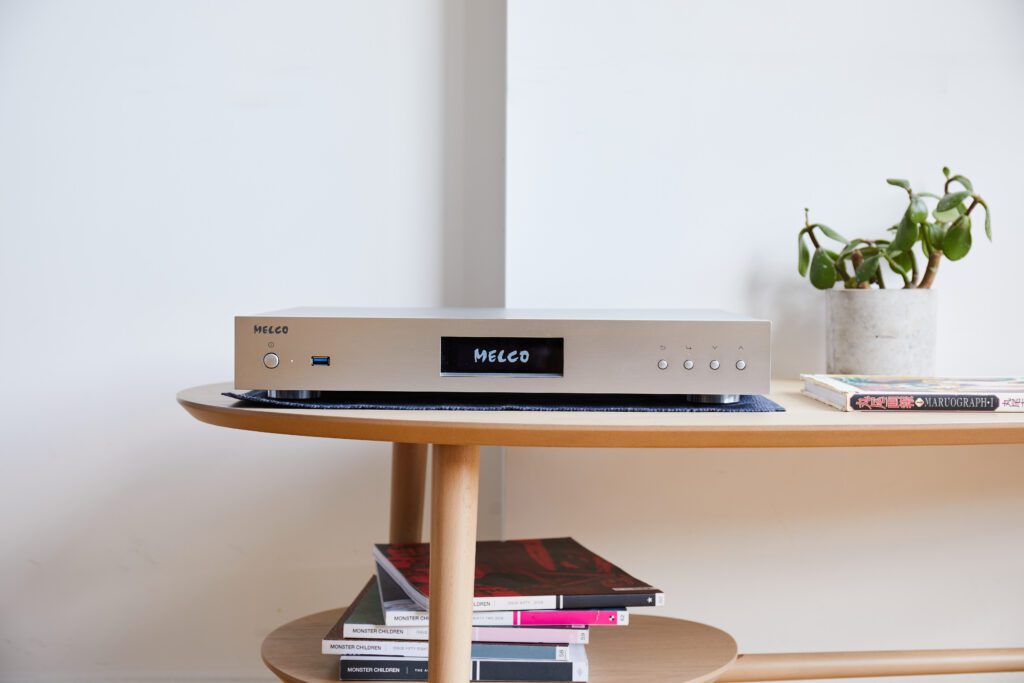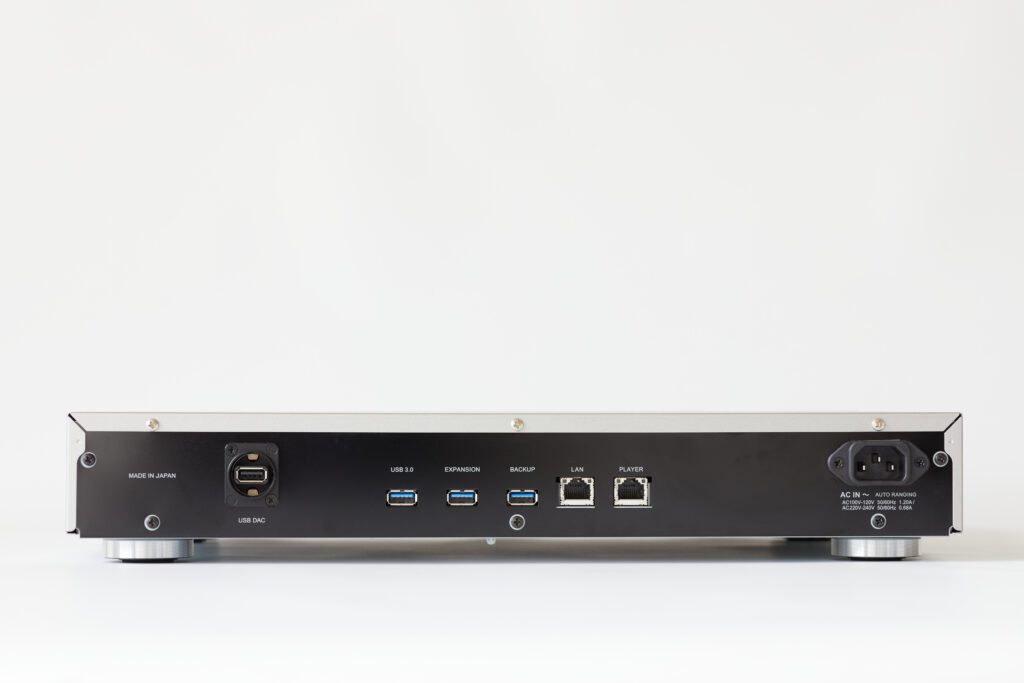
You might think that because they have no moving parts, solid-state drives (SSD) would be inherently superior to their spinning cousins (HDDs or hard disk drives), but there is much debate about which sounds the best. Melco’s new SSD-equipped N50-S38 is midway between the company’s N100 server and its range-topping N1Z EX and N10 models. It inhabits a case that’s virtually identical to the outgoing N1A, yet that is the only similarity between the two. It sticks out as being the only full-width server in the Melco range. It’s worth mentioning that the Melco servers are also streamers by virtue of their USB output; all they require is an external DAC to form a complete digital source.
The N50 is unusual among an extensive range of music libraries, as Melco prefer to call them, in having SSD storage onboard as standard. An SSD variant of the N1Z EX is available, and it’s the most expensive model in the range, but it’s not always recommended above the HDD alternative. The general feel seems that the SSD-based N1ZS is the best option for those who primarily listen to acoustic music but that the N10 is arguably better suited to those with broader tastes.
SSD… the disc for me?
I’m told that the N50 uses SSDs because the technology behind them has advanced significantly recently, and Melco has removed the elements that make them a poor choice for audio. One is that they are built for speed of access, which is unnecessary in a music server and detrimental because it produces electrical noise. Another is wear levelling. To compensate for the limited read/write cycles available from flash memory, PCs use wear levelling software; in audio, it’s a write-once-read-many situation, so that’s something else that can be bypassed.

The N50 offers a slightly odd 3.84TB of SSD storage (the reason for the S38 suffix), but the drive was chosen for its size and sound quality reasons. It’s cosseted in a ‘rigid, layered cradle’ to keep vibration at bay. This suggests that SSDs are sensitive to vibration in much the same way resistors, capacitors etc. seem to be. Just because something doesn’t move doesn’t mean it’s immune to its environment.
The press release for this server includes terms like ‘enhanced main [circuit] board’ and the ‘dynamic power supply having 25% more output’, which it turns out to relate to the outgoing N1A that it resembles. However, it’s only the casework that remains from that model, something that becomes more apparent when you look at the back panel and discover a chunky Neutrik housing around the USB output that’s dedicated to the all-important DAC connection. This was sonically at least a relatively weak point of the N1A, and as a result, that server generally sounded better when used with a network streamer. The N1A Mk1 had USB3 DAC architecture, its Mk2 successor and the N50 have USB2. Another case of what’s good for speed isn’t good for sound quality.
Software-wise the Melco servers have a few features you don’t often see. While the N50 is Roon Ready when you select that option via the OLED display, it can also be run from Melco’s control app. This isn’t the slickest of devices, but it can access Qobuz and Tidal and vTuner net radio, which are standard options. What is apparently unique to Melcos is the ability to download content directly from Qobuz and HighResAudio, the German site primarily dedicated to classical music. Whereas you usually have to download new music files to a PC and then transfer them to a server, this approach reflects one of Melco’s original goals, which is to be able to manage and stream music without the need for a computer.
Server options
Also, you can choose between Twonky and Minim servers, the latter providing a much broader array of parameters for tagging music with a specific aim of making it easier to access classical recordings where things are not as simple as artist/album/track but extend to multiple composers on a single release by a given artist and/or orchestra. Melco includes a basic version of SongKong software for metadata management purposes that offers a far greater degree of automation and tagging fields than other such systems. This latter is hugely flexible and, as a result, not entirely intuitive but has the potential to be a huge help when it comes to sorting an extensive collection of music files.
I connected the N50’s USB output to an iFi Pro iDSD DAC running in non-oversampled, tube output mode with USB cables from CAD and Network Acoustics, a combination that delivered remarkably smooth and clean sound. I spoiled myself by buying the Melco N10 reviewed earlier in the year, so it was not hard to hear that this rather more affordable server was not as revealing of fine detail. Still, it does have the same ability to push the noise floor down an awfully long way. The problem with server/streamers is that they are run by processors inclined to produce electrical noise, which, while it can’t be heard directly, has the effect of masking the quieter sounds in any piece of music. These quiet sounds, combined with the fundamentals of each note, make the overall presentation more realistic and natural. Electrical noise also creates the hard, cold sound associated with early digital and today marks the difference between good and wrong digital sources.

The Melco N50 is a very good digital source. That much became clear fairly immediately; after several hours of listening, that rating had to be upgraded to ‘excellent’. The speed and power it brought to Patricia Barber’s ‘Company’ [Modern Cool, Premonition] were thrilling; the double bass, in particular, goes all the way down but remains articulate thanks to the resolution of this streamer and the brilliance of the player. This track can sound bombastic on lesser sources. The combination of high-energy playing with even small amounts of low-level noise can become tiring and aggressive. Here it was only the music that was hitting hard. The hardware itself did not intrude or exaggerate for extra dramatic effect but sat back and let the groove flow.
This is also a very revealing piece of kit, digging into everything it streams and bringing out the fine details that make for a convincing musical experience. I love the way it places instruments in a precise three-dimensional soundstage, making space for the harmonics of each to radiate into the room. It’s a clean but not clinical sound, one where the only edges are from the attack of each note. This creates a sense of speed in many pieces and the effortlessness of more relaxed works.
A real impression
John Martyn’s BBC Radio 1 Live in Concert [Windsong] has some lovely songs, but the one that made a real impression with this Melco was ‘Head and Heart’. Small-scale voice and guitar are more straightforward to reproduce than larger groups, but it’s not always this easy to suspend the sense of disbelief by merely closing your eyes. I suspect it’s about as near as we can ever get to time travel. A slightly larger performance was provided by Keith Jarrett on the London leg of his Testament album [ECM]. Here you often get the sense of Jarrett stamping on the stage, but the N50 showed more of the character of the venue and made the playing highly engaging by avoiding any edginess; you can almost feel him rocking on the stool and leaning into the keyboard as he channels what he plays directly from a higher plane. When improvisation is this good, it’s hard to imagine a stronger psychic connection between performer and listener.

Those impressions were gained with PMC’s remarkable Fenestria loudspeakers; later, I used the N50 with the Enleum AMP-23R and some much smaller PMC twenty5.21 stand-mounts, which proved to be a real greater than the sum combination. Revealing significant differences between recordings and bringing out the emotional message with extraordinary ease. Tracks like Olivia Trummer’s ‘Sharing My Heart’ [Fly Now, Contemplate] proved so moving that a lump appeared in my throat.
With the N50-S38, Melco has proved that SSD has an awful lot of potential for audio when it’s managed correctly. This company is part of a much larger Japanese organisation that specialises in IT. This has given it the know-how to produce a stunning server/streamer that allows users to get far more out of digital music files than they might imagine possible.
TECHNICAL SPECIFICATIONS
- Type: Solid-state music server with SSD storage
- Storage: 3.84TB SSD hard drive
- Network connection: RJ45 Ethernet
- Digital Outputs: RJ45 Ethernet direct, USB 2.0
- Back up connection: USB
- Formats supported: DSF, DFF, FLAC, WAV, ALAC, AIFF, AAC, MP3, WMA, OGG, LPCM
- Streaming services supported: Qobuz, Tidal
- User Interface: Melco Music HD, Roon Ready
- Other Features: UPnP server, DLNA device compatible
- Dimensions (H×W×D): 70 × 436 × 352mm
- Weight: 7kg
- Price: £4,999
Manufacturer: Melco Audio
URL: melco-audio.com
UK Distributor: ADMM
Tel: +44(0)1252 784525
Tags: MELCO N50-S38 MUSIC SERVER
By Jason Kennedy
More articles from this authorRead Next From Review
See all
Reiki Audio SuperSwitch Master Pro + Servant Pro
- Mar 27, 2024

Melco Audio N1-S38 music server
- Mar 27, 2024

Focal Utopia 2022 headphones
- Mar 27, 2024











